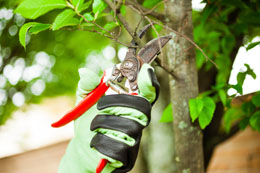Trimming or pruning a tree becomes a must for various reasons. If you are planning doing it yourself, then these guidelines may help you out.

Most of us grow trees around our homes for ornamental purposes. They render a great landscape to our yard and also provide us with fresh air. However, growing them comes with a responsibility of caring for them and ensuring their proper growth. Trimming a tree is one such responsibility that the home owners are expected to undertake periodically. However, you need to know a few basics if you wish to do the job yourself.
How to Trim a Tree on Your Own
Purpose of Trimming
Trees can be trimmed for various reasons, such as safety, health, aesthetics, etc. Often, you are at a risk of injuries or property damage due to falling of overgrown branches. Sometimes, they may obstruct your view or the branches may interfere with the access of the utility lines. Also, trimming becomes a must to protect the tree from diseases or insect infestation. Moreover, you also need to do it to improve its overall appearance, especially if you have planted it to enhance the beauty of your home.
Right Time
The right time to trim would primarily depend upon the individual species of a tree. Flowering ones set their blossom a year prior to their bloom. Therefore, if you trim them after their blossom, you might cut off the buds and the tree may not bloom in the following season. Therefore, the right time to trim them is 3 weeks after their bloom. Anytime after that, you are at risk of cutting a young and fresh blossom. Others can be trimmed in winter when they are dormant.
Choosing the Right Tool
Powered chainsaw is usually an ideal tool for trimming trees. However, if you do not have a prior experience with handling this tool, you should not go for it. In this case, a pruning saw with a telescopic handle may do the job. Shears can be used to cut shoots or relatively smaller branches. Pole saw is also an effective tool for branches that are small to medium.
Proper Method
Firstly, you will have to assess the condition of your tree. Depending upon the purpose for pruning, you will have to select the branches. If you are doing it to eradicate the diseased branches, then you might have to do an extensive inspection to determine the extent of disease spread. You will have to trim down all the affected branches as well as those already dead due to the disease. If you are pruning it for aesthetic purposes, then you will have to be very careful about the amount of branches you trim. Normally, you should never cut more than 25% of the crown. Also, while doing so care must be taken that you don't tear the trunk and cause damage to the stem. Branches should be always cut at the collar of the tree, which is a node where the branch meets the trunk.
- To begin with, make a wedge-shaped cut on the inner side of a branch, about 6 inches from the collar.
- Make the second cut away from the first and towards the end of the branch from top.
- Trim the branch completely leaving a stub.
- Make the final cut as close as possible to the collar.
- Do not close the wound with paint, instead leave it open to heal naturally.
- If you must, use a latex pruning sealer which protects the wound from insects.
For pruning taller trees, you must take proper precautions and make provisions to alleviate damage from falling branches. It is not recommended that you use a ladder for this purpose. You should then leave the job to a professional arborist.






 Most of us grow trees around our homes for ornamental purposes. They render a great landscape to our yard and also provide us with fresh air. However, growing them comes with a responsibility of caring for them and ensuring their proper growth. Trimming a tree is one such responsibility that the home owners are expected to undertake periodically. However, you need to know a few basics if you wish to do the job yourself.
Most of us grow trees around our homes for ornamental purposes. They render a great landscape to our yard and also provide us with fresh air. However, growing them comes with a responsibility of caring for them and ensuring their proper growth. Trimming a tree is one such responsibility that the home owners are expected to undertake periodically. However, you need to know a few basics if you wish to do the job yourself.